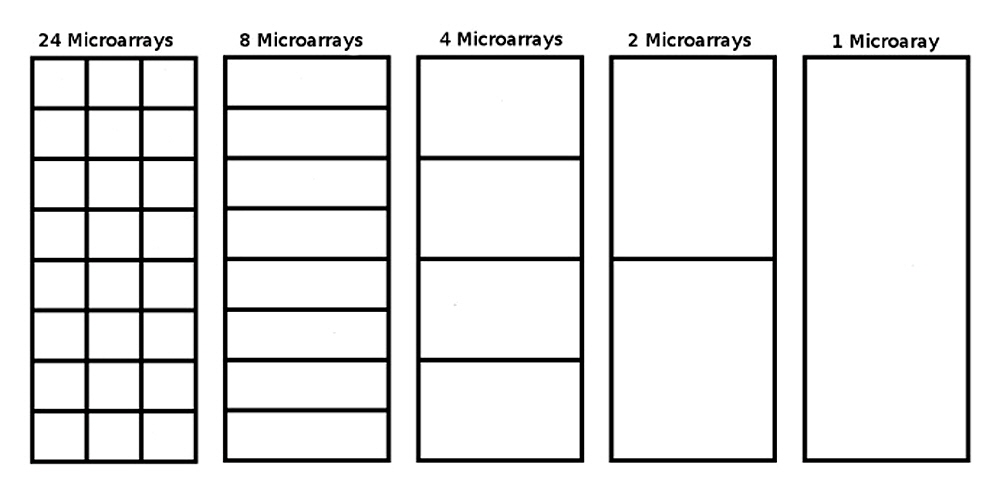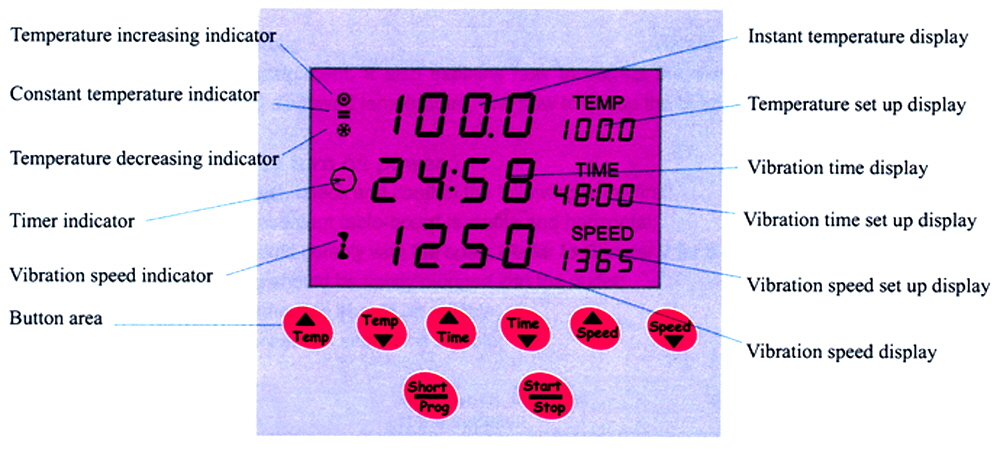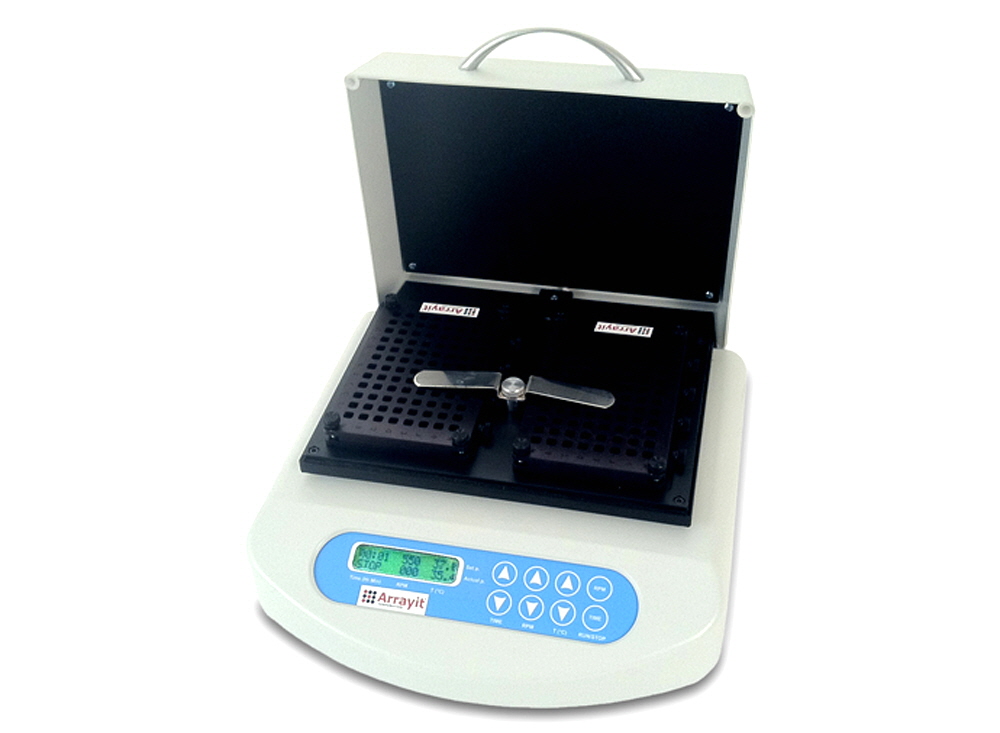Hybridization Station
Data Sheet
![]() Shop this product in our online store
Shop this product in our online store
Arrayit | Microarray hybridization stations Array Plate MMHS2 digital temperature control rotational mixing life sciences research
Instruments - Microarray Processing - Array Plate Multi-Well Microarray Hybridization Stations for Rapid and Efficient DNA and Protein Microarray Testing and Screening

Arrayit offers high throughput hybridization instrumentation for microplate formatted microarrays configured in 4x8, 4x16 and 4x24 multi-well hybridization cassettes. Hybridize and react up to 96, 192 or 384 DNA, protein, peptide and carbohydrate microarrays simultaneously using our 1, 2 and 4 plate systems. These digitally controlled instruments with peltier heating and cooling (ambient to 100ºC) and orbital mixing (300-1,500 rpm) accelerate the full gamut of microarray applications as well as cell studies, RNA transcription, immunoprecipitation, enzyme kinetics, and more. Arrayit Array Plate technology is finding increasing usage in miniaturized immunoassay deployment for research, life sciences and molecular diagnostics applications.
Table of Contents
Introduction
Quality Control
Product Description
Instrument Components
Technical Assistance
Short Protocol
Complete Protocol
Troubleshooting Tips
Recommended Products
Ordering Information
Safety Information
Warranty
Introduction
Congratulations on taking an important step towards improving the economies of scale, quality and speed of your life sciences, medical, diagnostics and agricultural research. This booklet contains a complete set of protocols outlining the steps and principles needed to use Arrayit’s Multi-Well Hybridization Station.
Quality Control
Arrayit ensures the performance of this product line. Rigorous quality control monitoring on a instrument-by-instrument basis guarantees that the manufacturing, performance and safety benchmarks exceed the highest industry standards.
Product Description
Arrayit Array Plate Multi-Well Hybridization Stations have been designed and developed to rapidly and efficiently hybridize and/or incubate DNA, protein, carbohydrate and peptide microarrays. Multi-Well Hybridization Station customers will appreciate the following product features:
- Easy-to-use digital interface
- Microcomputer control of timer, heating and cooling, and mixing operations
- Operations progress easily visible on high-luminosity 3-color digital display
- Alloy block allows rapid heating and cooling
- Versatile block accommodates microplates and single tubes
- Compatible with microarray microplate hardware AHC4X8S, AHC4X8L AHC4X16 and AHC4X24 (each requires a based that is easily changed by the end user)
- Temperature range: ambient to 100°C (MMHS110V and MMHS220V)
- Temperature range: ambient to 60°C (MMHS2 and MMHS4)
- Timer range: 1 min to 100 hours
- Mixing speed: 300-1,500 RPM
- Mixing amplitude of microwell samples: 3 mm
- Temperature control accuracy ±0.5°C
- Display accuracy ±0.5°C
- Temperature uniformity ±0.5°C
- Heating time from 20°C to 100°C: 10 min (MMHS110V and MMHS220V)
- Heating time from 25°C to 37°C: 10 min (MMHS2 and MMHS4)
- Cooling time from 100° to 20°C: 10 min (MMHS110V and MMHS220V)
- Dimensions (L x W x H): 33 x 27 x 17 cm = 13 x 10 x 7 in (MMHS110V and MMHS220V)
- Dimensions (L x W x H): 27 x 26 x 13 cm = 11 x 10 x 5 in (MMHS2)
- Dimensions (L x W x H): 38 x 39 x 14 cm = 15 x 15 x 6 in (MMHS4)
- Net weight: 8.5 kg = 18.7 lb (MMHS110V and MMHS220V)
- Net weight: 6.1 kg = 13.4 lb (MMHS2)
- Net weight: 8.8 kg = 19.4 lb (MMHS4)
- Power requirements: 110-240V AC at 50/60Hz and 150W (MMHS110V and MMHS220V)
- Power requirements: 110-240V AC at 50/60Hz and 40W (MMHS2)
- Power requirements: 110-240V AC at 50/60Hz and 50W (MMHS4)
Instrument Components
- Array Plate Multi-Well Hybridization Station, 110V or 220V
- Alloy block instrument cover
- Voltage-appropriate power cord
- Replacement fuses (2 each)
- Replacement instrument feet (4 each)
- Allen wrench for block removal
Technical Assistance
Please contact us if you have any comments, suggestions, or if you need technical assistance. By electronic mail: arrayit@arrayit.com (under the subject heading, please type Arrayit technical assistance). By email: arrayit@arrayit.com, Monday-Friday PST 9:00 AM-6:00 PM. Please remember that we want to hear about your successes!
Figure 1A. Pictured is the Arrayit Multi-Well Hybridization Cassette with wells configured in a 4 x 24 configuration (Cat. AHC4x24) with 4 glass substrate slides of and a silicone gasket and anodized aluminum lid to create 24 individual reaction areas for 24 microarrays per slide and 96 individual reaction areas for 96 microarrays per cassette.

Figure 1B. Shown are the formats compatible with hybridization cassettes by modification of the gasket or using a different hybridization tool. The cassette is sealed with microplate foil seals to elminate sample evaporation during hybrdization of the 96 microarrays. The silicone gaskets can be modifed to hybridize different numbers and different sizes of microarrays. Please contact us directly (arrayit@arrayit.com) for modified gasket pricing.

Figure 2. The Multi-Well Hybridization Station can be equipped with several different types of interchangble blocks to hold tubes, plates, chambers and cassettes.

Figure 3. Photograph of the heating and cooling block that transfers temperature directly to the glass microarray substrate slide. The block shown here accommodates the 4x24 well (Cat. AHC4x24) hybridization cassette. Interchangeable blocks are available for 4x16 hybridization cassettes, single tubes and other types of hardware.

Figure 4. Schematic diagram of the Array Plate Multi-Well Hybridization Station instrument display including temperature, time and vibrational mixing speed. The display reports the instrument indicators (left), the real-time readouts (center) and the programmed settings (right). The button area at the bottom of the display allows the user to toggle in temperature, time and mixing speed, as well as to start and stop the instrument.
Short Protocol (Steps 1-6)
1. Configure the Array Plate Multi-Well Hybridization Station on an approved laboratory bench.
2. Prepare a plate of microarray samples.
3. Place the array plate on the instrument heating block.
4. Program run time, temperature and mixing rate.
5. Run the program.
6. Remove the reacted samples and turn off the instrument.
7. Wash using Microarray Wash Trays.
Complete Protocol (Steps 1-6)
1. Configure the Array Plate Multi-Well Hybridization Station on an approved laboratory bench. Upon receipt of the instrument, carefully unpack all of the components and make sure the components received include an Array Plate Multi-Well Hybridization Station (110V or 220V), an alloy block instrument cover, a voltage-appropriate power cord, replacement fuses (2 each), replacement instrument feet (4 each), and an Allen wrench for block removal. Place the instrument and components on a laboratory bench, protected from splashing liquids, strong air currents and other environmental factors that would diminish instrument safety and performance. Connect the domestic version 110 volt version Array Plate to an appropriate 110 volt electrical outlet, or the 220 volt international version Array Plate to an appropriate 220 volt electrical outlet. Power up the instrument by pressing the toggle switch on the rear instrument panel.
2. Prepare a plate of microarray samples. The Array Plate accommodates a variety of microarray microplate reaction cassettes such as our AHC4x8, 4x16 and 4x24 well tools, as well as single tubes and other types of microarray hardware. For the 4x8, 4x16 and 4x24 tools, microarrays should be printed on 25 x 76 mm glass substrate slides 1x8, 2x8 and 3x8 patterns, respectively, for a total of 48, 64 (2x8x4) and 96 (4x16x4) microarrays. The microarrays should be processed, blocked and assembled into the Hybridization Cassettes and sealed with a foil seal. Hybridization solution (50 - 75 µl per well for the 4x16 adn 4x24 tools, and 150 to 300 ul for the 4x8 well format) should be added to each well immediately prior to transferring the hybridization cassette onto the Array Plate instrument. The wells should be covered with the appropriate foil seal to prevent well-to-well contamination and evaporation.
3. Make sure the Array Plate instrument is configured with the correct alloy heating block for proper contact between the slide and heating base. Place the array plate on the instrument heating block to that the glass makes contact with the metal base. Heating blocks are available and can be interchanged by loosening the four Allen bolts and swapping in a different block. Make sure to power the instrument off and cold before interchanging the heating and cooling blocks. Place the AHC4x8, 4x16 or 4x24 Hybridization Cassette on the heating block so that the array plate falls into place around the perimeter of the four alloy heating elements. The correct positioning of the array plate on the instrument ensures direct contact between the four alloy heating elements and the glass substrate slide, resulting in rapid, precise and highly uniform temperature control of each microarray experiment. Place the alloy block instrument cover over the array plate to prevent topical contamination and minimize thermal loss during the hybridization process. Seal cassette with foil seal.
4. Program run time, temperature and mixing rate. Array Plate Hybridization Stations are fully programmable for time, temperature and mixing speed. A schematic of the instrument display is provided in Figure 4. Use the arrowed buttons on the bottom of the display to program incubation temperature, incubation time and mixing speed. The Short button initiates mixing immediately and for a brief period to allow the user to access a given mixing speed. Releasing the Short button terminates the brief mixing process. Protein microarray hybridization reactions typically use 37ºC for 1-4 hours at a mixing speed of 300 rpms, DNA hybridization reactions at 42C. Different experiments and applications may use different instrument settings. The programmed values will appear on the right side of the instrument display (see Fig. 4). Pressing the Start button will initiate the program, at which time the temperature, time and mixing speed will appear in the center of the instrument display in real time (see Fig. 4). The left portion of the display presents the user with a series of instrument indicators including direction of temperature change, timer and speed.
5. Run the program. Allow the programmed hybridization process to proceed for the complete duration of the programmed setting. Once the run is complete, press the Stop button to complete the hybridization process.
6. Remove the reacted samples and turn off the instrument. After the hybridization process is complete, remove the instrument cover and then remove the array plate from the alloy heating block on the Array Plate instrument. Disassemble the array plate rapidly and transfer the hybridized microarrays into wash buffer immediately to begin the wash process. The entire cassete can be immersed in all of Arrayit buffer types. These steps must be performed quickly to prevent drying of the hybridization solution on the microarray surface. Power the Array Plate instrument off using the toggle switch located on the rear instrument panel and place the instrument cover back on.
7. Wash using Microarray Wash Trays on a suitable shaker. Click here to view the Array Plate technical video.

Figure 5. Arrayit Array Plate Multi-Well Hybridization Station (Cat. MMHS2) with 2 plate capacity for simultaneous reactions of up to 192 microarrays. Compatible with AHC4X8, AHC4X16 and AHC4X24 hybridization cassettes.

Figure 6. Arrayit Array Plate Multi-Well Hybridization Station (Cat. MMHS4) with 4 plate capacity for simultaneous reactions of up to 384 microarrays. Compatible with AHC4X8, AHC4X16 and AHC4X24 hybridization cassettes.


Figure 7. Arrayit Array Plate Multi-Well Hybridization Station accelerates hybridization rates by approximately 10-fold compared to static cover slip hybridization reactions. Two genotyping microarrays were hybridized for 30 minutes at 42° in 30 µl under a glass cover slip (upper panel) or in 200 µl at 500 rpm using an Array Plate Hybridization Station (bottom). Two-color red-green probes mixtures were prepared in 1X UniHyb® 2 Hybridization Solution at final probe concentration of 1.6 nM (top) and 0.2 nM (lower panel). The microarrays were washed for 5 min at 45° in Wash Buffer 1, 5 min at room temperature in Wash Buffer 2, 1 sec in Wash Buffer 3, spun dry for 3 sec in a Microarray High-Speed Centrifuge and scanned using an Arrayit InnoScan® 710AL Two-Color High-Speed Fluorescence Scanner at high laser power and gain 10 in the red channel and gain 5 in the greeen channel. The Array Plate produced stronger signals even with the 6.7-fold greater probe dilution, indicating an approximately 10-fold increase in hybridization signal with 500 rpm Array Plate mixing.
Troubleshooting Tips
Readout is not visible in the instrument panel.
- Power cord not connected, instrument power off, or blown fuse. Please make sure to connect the power cord to an appropriate electrical outlet. Make sure that the toggle switch is set to the “on” position on the rear instrument panel. Blown fuses are replaced using the replacement fuses provided with the instrument. The fuse port is located next to the power switch on the rear instrument panel.
Instrument produces noise during mixing.
- Improper block being used, excessive mixing speed, uneven laboratory bench or worn instrument feet. Make sure the alloy heating and cooling block fits properly with the 4x16, 4x24 or other hybridization hardware. Make sure that the mixing speed is appropriate for the application and hybridization hardware. The laboratory bench should be planar and level. Worn instrument feet can be replaced using the replacement feet provided with the instrument.
Recommended Products
VIP™ Diagnostics Packages
NanoPrint™ 2 LM60 and LM210 Enterprise Level Microarrayers
SpotBot® 4 Personal Microarrayers
InnoScan® Fluorescent Microarray Laser Scanners
SpotLight™ Personal Fluorescence Microarray Scanners
Arrayit Super Microarray Substrate Slides
Arrayit PCR Purification Kits
Arrayit 384-well microplates and lids
Arrayit microplate adhesive foil seals

